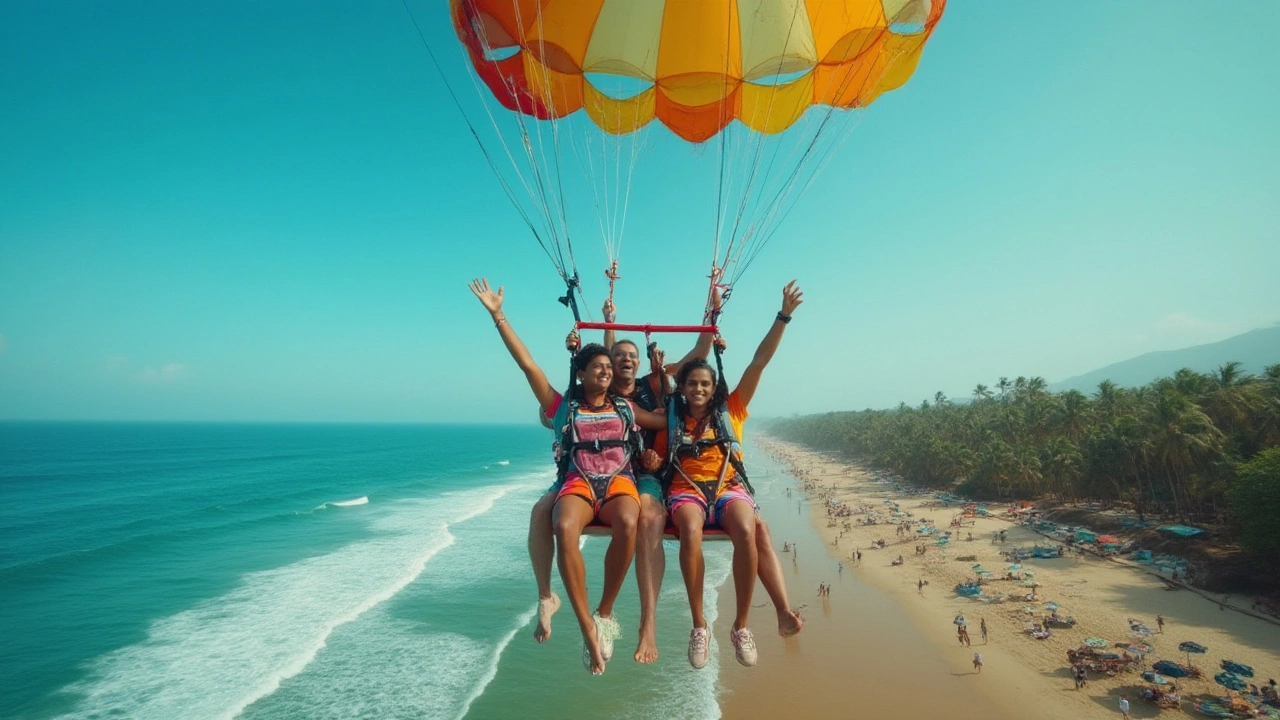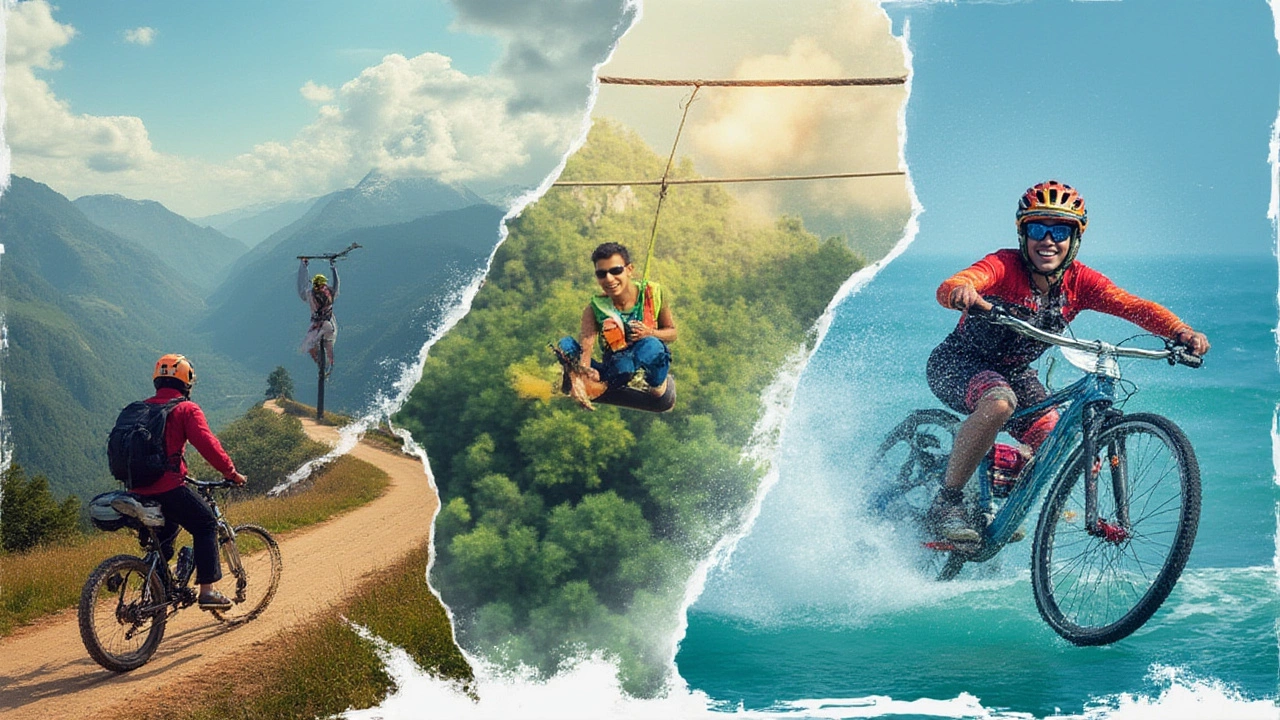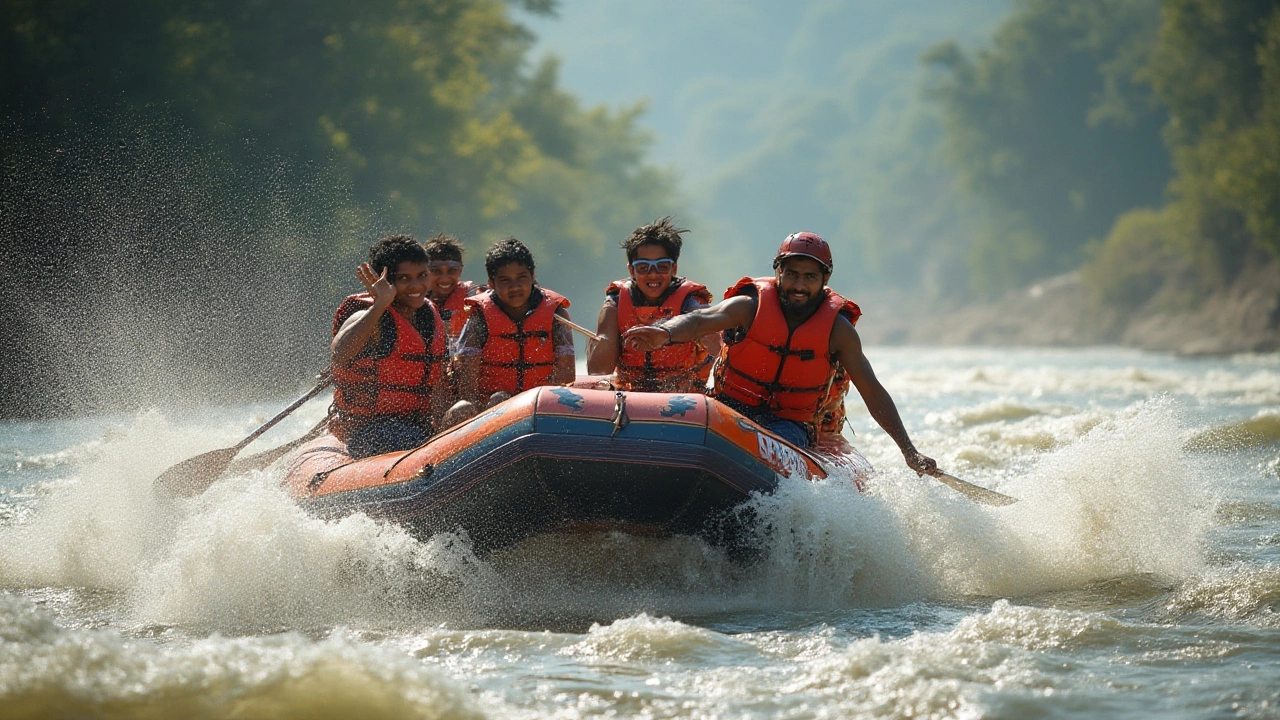Bungee jumping from 270 feet, white water rafting through gushing rivers, paragliding over emerald hills—India is packed with places to get your heart pounding. Most people don't realize how wild and extreme this country can get until they dive in (sometimes, literally). Sure, you’ll find calm temples and palaces, but there’s another side to India: turbocharged action in every corner. You don’t need to be a pro, but you do need to pick the right spot if you want to make it count. Not every place is equal—some deliver jaw-dropping, Instagram-worthy adventures, others are more hype than reality. So, where should you actually pack your harness, helmet, or hiking boots?
Rishikesh: The Adventure Capital That Never Disappoints
Rishikesh isn’t just known for yoga. This small city in Uttarakhand is basically the OG for anyone chasing an adrenaline fix in India. Let’s start with river rafting on the Ganges. The rafting stretch here is famous for its Grade III and Grade IV rapids—named things like “Roller Coaster” and “The Wall.” That means you’re in for more than just a splashing good time—brace yourself for bucketloads of cold river water crashing into your face as you cling to the raft. And river rafting here runs from September to June, unless the weather gets really rough.
Bungee jumping addicts, this is where India’s first fixed-platform jump was launched, plunging 83 meters down from a cliff top. It’s higher than a 20-story building. They use equipment imported from New Zealand, and the safety record’s solid—no random knots, no creaky harnesses. You’re good.
Want more? Try zip lining over the river at up to 140 km/hr or cliff jumping right in the Ganges. The area is now drawing in adventure fans from across the world, with international companies (from Australia to Europe) running certified adventure courses. Trekking options extend up into the Himalayas, too, with easy half-day walks or multi-night camping if you want more of the wild. There’s even paragliding, mountain biking, and waterfall rappelling. The region’s mix of rivers, cliffs, and thick forests give it the variety you need for any challenge.
Travellers usually gather at hostels or riverside camps, and you’ll always find a guide happy to swap stories or offer tips. The local scene is electric, especially during the peak season—everyone is there to push their limits and chill by bonfires with a view. Quick tip: Pack quick-dry clothes, water shoes, and don’t skip the evening Ganga Aarti on the riverfront once you’ve cleaned up. Even adrenaline junkies appreciate mellow moments.
Manali & Solang Valley: A High-Altitude Playground
If you prefer crisp mountain air and snow-dusted backdrops, Manali and nearby Solang Valley are adventure hotspots that deliver the goods for all seasons. The region is located in Himachal Pradesh, and when you get there, you’ll stare straight at craggy Himalayan peaks. In the winter, Solang Valley turns into a snow sport hub. We’re talking skiing lessons for beginners, pro slopes for the brave, and plenty of snowboarding for the ones who want to shred powder. They’ve got cable cars that zip you up to stunning heights—don’t be surprised to see skiers on a glide one moment and paragliders the next.
Paragliding is huge here, thanks to those cliff-like slopes and thermals that keep you airborne longer than in most other places in India. The Solang ropeway and cable car are local favorites for breathtaking panoramas before you launch yourself off a takeoff point.
During warmer months (March to June and October to December), mountain biking is the name of the game. You can rent gear (and a guide, if you want) in Manali town, tackling thrilling downhill routes or scenic forest trails. Rivers like the Beas offer white-water kayaking, while zorbing (rolling down slopes in a giant inflatable ball) is a right laugh for groups.
Ever wanted to ride an ATV across a mud track? Manali’s got that covered. There’s also ziplining across gorges, rappelling, rock climbing, and ice climbing for winter pros. Locals recommend trying their signature “snow scooter rides” if you’re caught there in peak winter—these things move fast and honestly feel like racing a snowmobile in a Bollywood chase scene. Manali also serves as the main gateway if you’re heading for long treks into Spiti, Lahaul, or even Leh. Book adventure activities at licensed operators for insurance coverage and the peace of mind that your gear isn’t going to betray you mid-jump.
| Adventure Sport | Best Season | Notable Fact |
|---|---|---|
| Bungee Jumping | Oct-June | 83-meter jump, highest in India (Rishikesh) |
| Paragliding | March-June, Oct-Dec | Solang Valley is top-rated globally |
| Skiing | Dec-Feb | Solang and Auli are India's best slopes |
| River Rafting | Sept-June | Grade III/IV rapids in Rishikesh & Manali |
A quick word to the wise: always check weather alerts before planning your trip. This region is gorgeous, but nature can be brutal. Carry an extra sweater, load up on sunscreen, and never feel shy about asking instructors about their certifications. If you love a mashup of adventure sports and cozy mountain stays, Manali and Solang Valley set the bar high.

Goa: Water Thrills Beyond the Parties
Most people fly to Goa for the parties, sun-tans, and seaside shacks, but the adventure sports scene here is criminally underrated. This patch of the west coast is a prime destination for water-based adventures. Think jet-skiing, wakeboarding, banana boat rides, and a crazy popular new thing called “flyboarding” where you literally hover above water. Seasoned folks can even try windsurfing; the conditions (especially at Candolim, Calangute, and Baga) attract international competitors every winter.
Parasailing here isn’t just a lazy cruise behind a boat—you’re often 100 meters up, pulled along the shore with a bird’s-eye view of palmy beaches and endless blue sea. For true thrill seekers, “scuba diving” at Grande Island is the thing to do. Marine instructors train beginners right in the shallows before heading out to coral reefs—don’t worry, the fish are more scared of you than the other way around. Water visibility is best November to April, and you can see clown fish, barracudas, and even sea turtles if you’re lucky.
Does beach safety worry you? Lifeguards patrol the main adventure beaches, and Goa’s tourism board introduced licensing in 2021 for all parasailing and jet-ski operators to keep things above-board. Group trip, stag night, romantic duo—there’s something for everyone here, and most organizers offer photo and video packages for your proof-of-bravery collection. Take a kayaking trip through the backwaters or, during monsoon months (June–September), switch to “white water rafting” which is rare along Indian coasts but happens here thanks to rain-swollen rivers north of Panaji.
If you want variety, Goa delivers big. There’s even bungee jumping and paintball, for those times when you need to burn off all those beach-side calories. Pro tip: Always slather on the sunscreen—Goan sun is unforgiving. And don’t take your safety gear for granted; double-check harnesses and lifejackets, especially when booking at smaller setups away from the main crowd. Got a GoPro? This place is perfect for action shots in and above the water.
Leh & Ladakh: Extreme Altitude, Extreme Sports
Ever wondered what it’s like to bike where the road signs read “world’s highest motorable pass”? Leh-Ladakh is where real adventure nuts face-off against altitude and tough terrain. The most iconic trek is the “Chadar Trek”—you walk on a frozen river, the Zanskar, at altitudes above 11,000 feet. This is peak Himalayan drama, running from January to February only. Guides train you to spot ice cracks, and you’ll camp in sub-zero temperatures. The bragging rights? Priceless.
Ladakh is a goldmine for bikers. Routes like Manali to Leh or Srinagar to Leh attract thousands every summer. Royal Enfield riders (and yes, even cyclists) brave freezing winds, stunning valleys, and dizzying mountain passes. Khardung La, the legendary motorable pass, sits at 17,582 feet—just don't underestimate the altitude sickness risk; acclimatize in Leh before heading up. Adventure companies here also offer ATV rides, sand dune bashing in Nubra Valley, and snow leopard treks in Hemis National Park for those who want their adventure wild and raw.
This region is also home to high-altitude white-water rafting on the Indus and Zanskar rivers—rapids are wild, and the cold water is next level. In warmer months, Ladakh’s crystal-clear lakes like Pangong and Tso Moriri make for epic kayaking if you can handle the chilly temperature. That landscape isn’t just eye-candy—it’s a mental and physical challenge, especially for first-timers in the mountains.
Quick reality check: phone networks are basic, power cuts are common, and you’ll learn to appreciate a hot bowl of Maggi noodles at some remote dhaba more than ever. Pack high SPF sunscreens; the sun at this altitude is brutal. If you’re prone to altitude sickness, carry meds (consult your doctor first). Make backup plans—Leh’s weather is famously unpredictable. If you love mixing staggering views, gutsy trails, and non-touristy experiences, this is the spot. Leh-Ladakh isn’t just beautiful; it's humbling, at every turn.

Other Top Adventure Hotspots: From Northeast to South
It’s easy to laser in on the most famous names, but adventure fanatics also rave about off-beat destinations that pack a punch. Meghalaya’s Cherrapunjee wins the title for “living root bridges” trekking—descend nearly 3,500 steps into rain-soaked jungles and cross bridges made from actual tree roots. Caving here is wild, especially in Mawsmai caves, where you crawl and wade through pitch darkness and underground waterfalls. If Meghalaya is all moss and mist, Sikkim is snowy and spectacular. Gurudongmar Lake hikes, Yumthang Valley’s hot springs, paragliding in Gangtok, and mountain biking—Sikkim reminds you that tiny states can pack a wild punch.
Down south, Dandeli in Karnataka wins if you crave the sound of wild rivers and thick forests—river rafting on Kali, coracle rides, and zip-lining over dense canopies. In Kerala, the backwaters aren’t just for honeymooners—try kayaking, river rafting in Bhoothathankettu, or bamboo rafting in Periyar Tiger Reserve for a unique twist. Tamil Nadu’s Yelagiri hills, with their paragliding and rock-climbing scenes, offer unexpected excitement right in the south.
Andaman & Nicobar Islands are all about the undersea world—scuba diving to see vibrant coral, snorkeling off Havelock Island, and even “sea walking” for non-swimmers. Safety records are solid, PADI-certified instructors are everywhere, and water clarity (especially in February–May) is unbeatable. The Northeast hills—Arunachal Pradesh, Nagaland, Mizoram—are waking up to ziplines, mountain bike trails, and high-altitude camps. For those who’ve “been there, done that,” these states are where you’ll find your next fix. Always check local regulations, as these regions are ultra-protective of their delicate environments and sometimes restrict access for conservation during certain months.
If you want the stats, here’s a quick rundown:
| Destination | Main Adventure Sport | Best Time To Visit |
|---|---|---|
| Rishikesh | Rafting, Bungee Jump | Sept–June |
| Manali/Solang | Skiing, Paragliding | Oct–March |
| Goa | Scuba Diving, Parasailing | Nov–April |
| Leh-Ladakh | Biking, Trekking | June–Sept |
| Andaman | Scuba, Snorkeling | Feb–May |
| Meghalaya | Caving, Trekking | June–Oct |
Bottom line? India is epic for adventure sports if you know where to look, plan for the right season, and pick quality operators. Never compromise on safety gear—or common sense. You'll return home with stories that last way longer than any tan lines or bruises. Just one last tip—keep emergency contacts handy, download offline maps, and always, always triple check your equipment before you take the leap.
